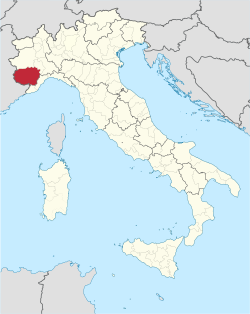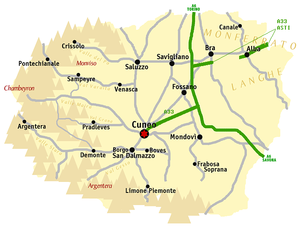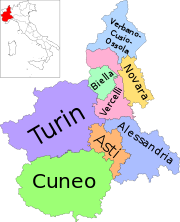Province of Cuneo
Province of Cuneo | |
|---|---|
 The provincial seat | |
 Map highlighting the location of the province of Cuneo in Italy | |
| Country | Italy |
| Region | Piedmont |
| Capital(s) | Cuneo |
| Comuni | 250 |
| Government | |
| • President | Luca Robaldo |
| Area | |
| • Total | 6,902 km2 (2,665 sq mi) |
| Population (30 June 2016) | |
| • Total | 590,309 |
| • Density | 86/km2 (220/sq mi) |
| GDP | |
| • Total | €17.987 billion (2015) |
| • Per capita | €30,423 (2015) |
| Time zone | UTC+1 (CET) |
| • Summer (DST) | UTC+2 (CEST) |
| Postal code | 12100 |
| Telephone prefix | 0171 |
| Vehicle registration | CN |
| ISTAT | 004 |
| Website | www |

The province of Cuneo (Italian: provincia di Cuneo; Piedmontese: provincia ëd Coni) is a province in the Piedmont region of Italy. To the west, it borders the French region of Provence-Alpes-Côte d'Azur (departments of Alpes-Maritimes, Alpes-de-Haute-Provence and Hautes-Alpes), to the north the Metropolitan City of Turin, to the east the province of Asti and to the south the Ligurian provinces of Savona and Imperia. It is also known as [la Provincia Granda] Error: {{Lang}}: invalid parameter: |link= (help) (Piedmontese for 'The Big Province'), because it is the largest province in Piedmont and the fourth-largest in Italy (following Sassari, South Tyrol and Foggia).[2] Briga Marittima and Tenda were part of this province before their cession to France in 1947.[3]
Administration
[edit]Its capital is the city of Cuneo.[4] Of the 250 comuni in the province, the largest by population are:
| Commune | Population |
|---|---|
| Cuneo | 56,201 |
| Alba | 31,346 |
| Bra | 29,593 |
| Fossano | 24,306 |
| Mondovì | 22,730 |
| Savigliano | 21,526 |
| Saluzzo | 16,971 |
| Borgo San Dalmazzo | 12,457 |
| Busca | 10,116 |
| Racconigi | 10,094 |
| Boves | 9,807 |
| Cherasco | 9,128 |
| Barge | 7,694 |
| Dronero | 7,065 |
Economy
[edit]Companies active in the province include:
- Michelin in Mondovì
- Miroglio in Alba
- Ferrero SpA in Alba
- Maina in Fossano
- Balocco in Fossano
- Merlo in San Defendente (Cervasca)
- Arpa industriale in Bra
- Bottero in Cuneo
- Mondo in Alba
- Mtm-Brc in Cherasco
- Abet in Bra
- Edizioni San Paolo in Alba
Many important industrial groups have branches in the province: Michelin (Cuneo and Fossano), Saint-Gobain (Savigliano), Valeo (Mondovì), Asahi Glass Co. (Cuneo), ITT (Barge), Diageo (Santa Vittoria d'Alba) and Nestlé (Moretta).[5]
Cuneo is also the land of important wines, mostly produced in the Langhe and Roero hills, such as Barbaresco, Barolo, Nebbiolo, Barbera and many others.
See also
[edit]References
[edit]- ^ Regions and Cities > Regional Statistics > Regional Economy > Regional Gross Domestic Product (Small regions TL3), OECD.Stats. Accessed on 16 November 2018.
- ^ Bole 2011, p. 82.
- ^ Construction de l'espace au Moyen Age: pratiques et représentations [Construction of space in the Middle Ages: practices and representations] (in French). Publications de la Sorbonne. 2007. p. 391. ISBN 978-2-85944-587-4.
- ^ Kresl & Ietri 2010, p. 138.
- ^ Holst-Warhaft & Steenhuis 2012, p. 76.
Sources
[edit]- Bole, David (2011). Innovative policies for Alpine towns: Alpine space small local urban centres innovative pack. Založba ZRC. ISBN 978-961-254-254-2.
- Holst-Warhaft, Gail; Steenhuis, Tammo (28 November 2012). Losing Paradise: The Water Crisis in the Mediterranean. Ashgate Publishing, Ltd. ISBN 978-1-4094-8846-0.
- Hall, Marcus (2005). Earth Repair: A Transatlantic History of Environmental Restoration. University of Virginia Press. ISBN 978-0-8139-2341-3.
- Kresl, Peter Karl; Ietri, Daniele (2010). The Aging Population and the Competitiveness of Cities: Benefits to the Urban Economy. Edward Elgar Publishing. ISBN 978-1-84980-693-0.



